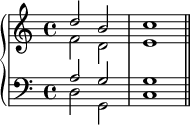終止式
閱讀設定

C大調,所以最尾三個和弦係 ii(Dm)、V(G)、I(C),結尾嘅 V–I 係完全終止式
終止式[註 1](英文:cadence)係和弦進行嘅一種;喺音樂上傳統上用嚟表示一句、一段仔、一大段或者成首音樂嘅結尾,但係所謂結尾並唔一定係指解決[1]。
西方調性音樂用嘅終止式主要有四種,分別係 「完全終止式」[註 1](perfect cadence)、「不完全終止式」[註 1](imperfect cadence)、「變格終止式」[註 2](plagal cadence)同 「阻礙終止式」[註 1](interrupted cadence)[1],當中不完全終止式同阻礙終止式表示嘅都係 「未解決」。
睇埋
[編輯]註
[編輯]- ↑ 1.0 1.1 1.2 1.3 譯名見:彩虹天主教英文中學 (無日期)
- ↑ 譯名見:〈布拉姆斯《韓德爾主題變奏曲與賦格》之分析與詮釋〉 (臺灣中文)。頁 58。喺2024年8月9號搵到。
參考資料
[編輯]- ↑ 1.0 1.1 Latham, Alison, 編 (2011). "cadence [close]". The Oxford Companion to Music (英文). 牛津大學出版社. 喺2024年8月9號搵到.
參考書目
[編輯]- 〈音樂術語〉 (香港中文)。彩虹天主教英文中學。喺2024年8月9號搵到。
